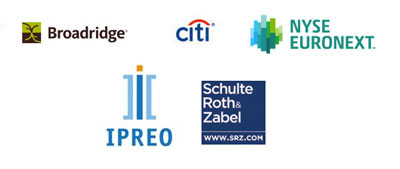Highlights from the eighth annual IR Magazine Think Tank – East Coast, which featured a strong international contingent
Please note: all comments are anonymous as IR Magazine Think Tanks operate under Chatham House Rules.
Leveraging the transformation: how to get the most out of the sell side
‘It defies economics how many analysts follow stocks when you look at volumes and margins on the sell side. But despite the decrease in volumes, the lack of participation in the equity markets and high correlations, demand from the buy side for research and access continues to grow.’
‘We’ve got a full roster of analysts covering us but there’s no upside to discouraging a new one. The first thing I try to understand is why a new analyst is picking us up. Even if I’m skeptical that it will get the multiple moved, the point is that the analyst could broaden the conversation, bringing in a point of view that hasn’t been heard before.’
‘Since I started as a sell-side analyst, the noise level and speed have increased so much. With the advent of BlackBerrys and iPhones, analysts’ notes come out so much faster, and the reaction is greater. Plus, the stable of analysts has expanded, with some 25-30 analysts covering the same stock, all of them calling our clients with blast voicemails and emails, each trying to break through that noise and come up with a message that can be heard and differentiated.’
‘We all know that outflows are exceeding inflows in the equity market, but the two areas that are receiving inflows are global mandates and equity income funds – this is because of the lack of yield in the marketplace. Several institutions are now taking analysts who were previously 100 percent US-focused and giving them global responsibilities.’
What’s your ideal shareholder base, and how do you get there?
‘Many companies are looking to dramatically reduce their retail bases, especially on the registered side, while others want to re-engage with retail investors. The former are open to a variety of ways of shaping and managing that base in a shareholder-friendly manner so they can free up more time and money to focus on the accounts that matter most. At the other end of the spectrum, some large corporations see their retail base as a missed opportunity, particularly for voting and branding.’
‘As a small-cap IRO, I have to use all the different tools available, from analytical targeting tools to what the sell side offers and even my own personal database that I’ve built up. I use regional niche firms that can add value with non-deal roadshows but aren’t necessarily providing research. Being a small-cap, I have to think outside the box. For example, I don’t always view high-turnover investors as a negative, because of the liquidity that they can bring.’
‘Coming out of down times in terms of the macro environment, we’ve been evaluating our shareholder base and making changes internally that will drive the types of investors that will be interested in us in the future. Most IROs plan, target and implement, then evaluate. But we’re looking at our growth profile and, knowing that it will change, targeting what the future shareholder base should look like while trying to understand the risks to our current base.’
‘All IROs should consider what an end to the Bush tax cuts for dividends would mean to their shareholder bases. They need to look at the tax exposure of their different investors, particularly at the mutual fund level, and how it will affect their interest in a stock.’
Regulation, governance and Election Day surprises
‘The good news for public companies is that most of the Dodd-Frank rule-making is already out there. This year the big development was the conflict minerals rule, requiring due diligence and potentially reporting from a lot of manufacturers. Still to come is the disclosure of internal pay equity, comparing the CEO’s compensation to the median, and pay-for-performance disclosure. The SEC is woefully behind schedule on these and there are even calls to repeal them, so the time frame isn’t clear.’
‘The JOBS Act’s changes to the general solicitation rules will add a twist to IR, with a lot more freedom for firms marketing private offerings. For emerging growth companies, there will be a lot more freedom around research coverage, producing a bifurcated market.’
‘During the first couple of years of say on pay, companies and investors were feeling each other out. Now companies are much more comfortable talking to shareholders about their compensation plans. Most importantly, it has to be someone involved in the compensation decision, someone who can go beyond the initial talking points.’
‘More and more investors are willing to look at alternative views on pay and performance, so you can tell your story in different ways, and companies are increasingly putting alternative metrics in their CD&As, which they feel are more important for investors to have than what they’re required to do by the SEC.’
‘As a large institutional investor, we find proxy advisers’ research helpful but not definitive. For example, with say on pay, we need some triage because we can’t look at 3,000 US companies in as much detail as we’d like, so we allow ISS to point out the red flags.’
IR Magazine Think Tanks are free, invitation-only events for select groups of corporate IROs. Find out about upcoming think tanks in London, Toronto, Chicago and New York here.
The IR Magazine Eest Coast Think Tank was sponsored by Broadridge, Citi, Ipreo, NYSE Euronext and Schulte Roth & Zabel.










